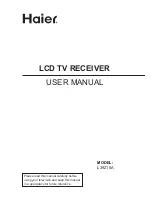
SERVICE INFORMATION - MODEL D70
THE CIRCUIT AND SERVICE INFORMATION SUPPLIED IS CONFIDENTAL AND
FOR USE BY DATONG AGENS ONLY.
1. Refer also to circuit diagram, data sheet, PCB layout.
2. Dismantling
Remove the eight screws holding both front and rear panels. This allows the
top half of the case to be removed. To remove the PCB remove the four screws
through the PCB. Leave the panels and controls soldered to the PCB leads.
3. Circuit description
A 'noisy' clock oscillator (IC10a, b) clocks the adress counter (IC8, IC9)
for the PROM (IC7) at a random rate. When informaton for the next character
is required a brief positive pulse is generated by Q4 which powers up the
PROM. Information at the PROM's outputs (pins 1, 2, 3, 4, 5, 6, 7, 9) is
then latched into IC5 and IC6 by a strobe pulse from pin 10 of IC3a. The
strobe pulse is slightly delayed from the power-up pulse by R8 and C5. The
strobe pulse is very short (mainly determined by R9 and input capacitance of
pin 10 of IC2b).
Information captured by IC5 determines the length of the next character.
Information stored in IC6 (shift register) determines the dot-dash sequence.
A 'low' into the preset inputs of IC6 signifies a dash and a 'high' dot.
Characters are read out at a rate determined by the main timing oscillator
(IC1a and b) under the control of the "SPEED" control. The square wave from
IC1b is converted into a single dot-plus-space (one cycle of the clock) or a
dash-plus-space (two cycles of the clock by IC2a and IC3b). When pin 4 of
IC2a is low dashes are produced and dot when pin 4 is high.
During the read out of a character IC5 counts up by one for every dot or dash
from the number originally loaded into it by the strobe pulse. When the
number reaches binary eight pin 2 goes high. This turns off the audio output
via R3 and after a delay determined by VR2 and causes D on IC2b to go high.
Furthermore pin 4 of IC2a is forced high via IC3c so that a "silent dot" is
produced. At the end of this "silent dot" Q of IC2b goes high and data for
the next character is called up from the PROM. The "silent dot" in effect
constitutes the inter letter space (3 time units) while the extra delay (if
any) selected by VR2 and C6 adds to the inter letter space.
After five interword spaces have been counted by IC4 its pin 2 goes high and
forces the production of a "silent dash" (via IC3d). It also presents a high
at pin 3 of IC5 during the load pulse and this transfers immediately to pin 2
after the "silent dash" thereby causing the letter to be followed immediately
by a "silent dot". The two together constitute the seven time unit interword
space.
When letters are being produced the combination IC8/IC9(a) counts cyclically
down in binary from 26 to 1. The state zero exists only for the time
























